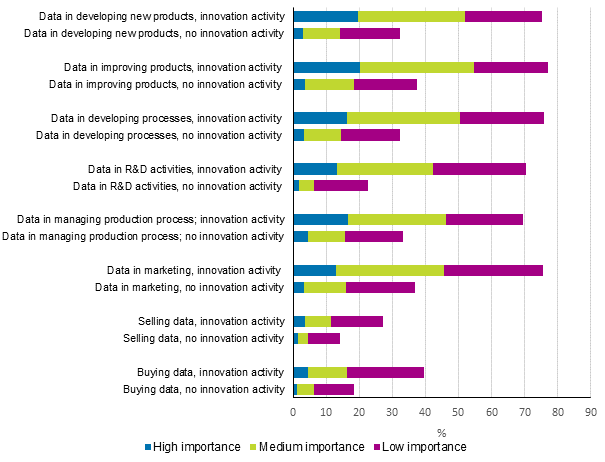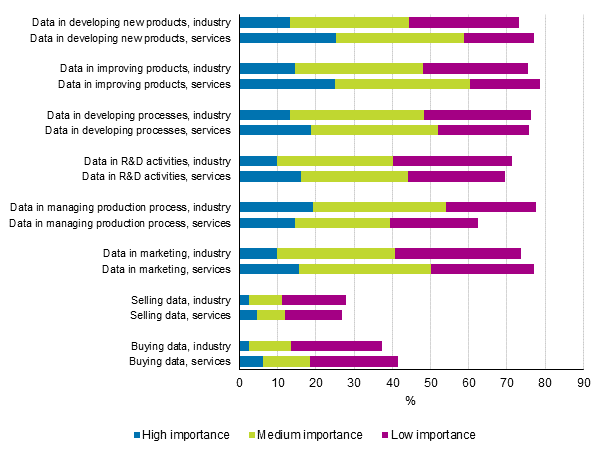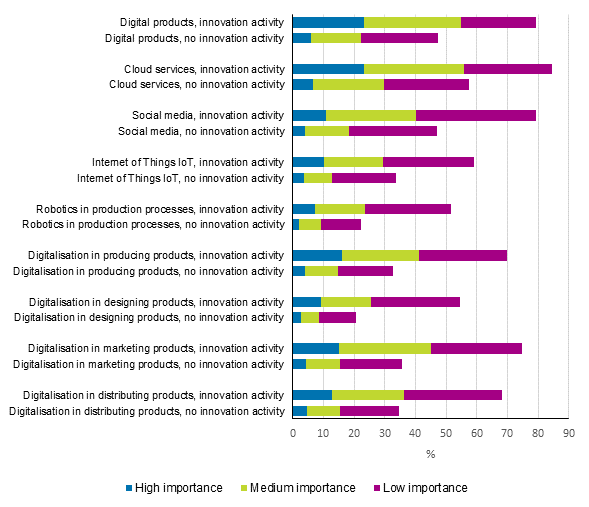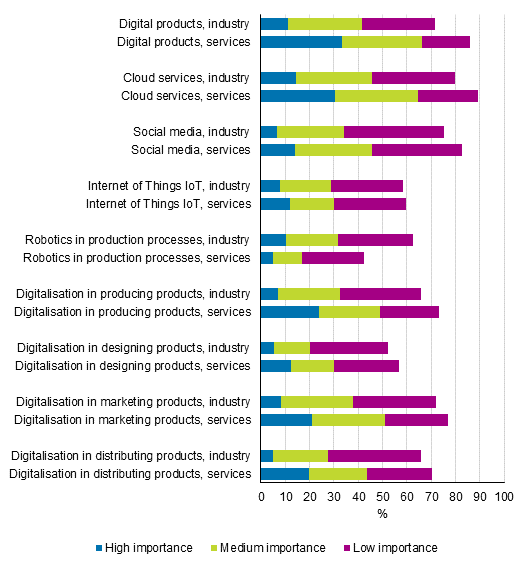15. Utilisation of data and digitalisation in enterprises' business activity
In the Innovation Survey, data referred to big data, data from the business’s own activity, and to public sector open data.
Twenty-six per cent of all enterprises reported at least one use of data as having high importance in 2016 to 2018. Data were considered of at least medium importance for at least one use of data in the enterprise's business activity by 32 per cent of enterprises. Data were regarded as having at most low importance by 14 per cent of enterprises and for 28 per cent of enterprises data were not significant in the review period.
Except for selling and buying of data, the uses of data in the inquiry receive fairly similar assessments of their importance. In production development and improvement, in development of process innovations, in research and development, in management of production processes and in marketing the importance of data was assessed as high by 9 to 14 per cent of all enterprises in the survey. These uses of data were assessed as having medium importance – depending on the use target – by 20 to 27 per cent of enterprises. In practice, 30 to 40 per cent of enterprises assessed these sub-areas of data economy as being of at least medium importance.
The utilisation of data was more significant and general for innovating enterprises than for other enterprises. Seventeen per cent of enterprises with innovation activity assessed the importance of data in managing the production process as high and 30 per cent as medium high. For other enterprises the corresponding shares were 4 and 11 per cent. In marketing the importance of data was assessed as high by 13 per cent of those with innovation activity, and as medium high by 33 per cent. For other enterprises the corresponding shares were 3 and 13 per cent.
Examined from all enterprises, data are used for different uses as widely in manufacturing as in services except for the utilisation of data in managing the production process, which is more common in manufacturing than in service industries. Even though the utilisation of data is in many respects equally common in manufacturing and service enterprises, in services the importance of data is higher than in manufacturing in product and process development and marketing. Buying of data from others is also assessed as important in service industries more generally than in manufacturing enterprises.
Figure 23. Prevalence and importance of different uses of data in 2016 to 2018, shares of enterprises with innovation activity and those with no innovation activity*

*Some of enterprises that did not have research and development or other innovation activity in the survey period have responded to questions on innovation activity in utilisation of data. In the question on data utilisation development work may have been interpreted more widely than in connection with innovation activity, for example, through development work in stages or continuous improvement.
Figure 24. Prevalence and importance of different uses of data in total industry and services 2016 to 2018, shares of enterprises with innovation activity*

*Some of enterprises that did not have research and development or other innovation activity in the survey period have responded to questions on innovation activity in data utilisation. In the question on data utilisation development work may have been interpreted more widely than in connection with innovation activity, for example, through development work in stages or continuous improvement.
The importance of data to enterprises’ business activity was also inquired in two previous Innovation Surveys with questions of more or less similar contents. As far as the data can be considered comparable in different periods, the importance of data in enterprises’ business activity appears to have grown from the previous measuring periods. Enterprises reported utilisation of data now more generally than before.
In connection with the Innovation Survey, digitalisation refers to transferring goods, services and their production or distribution to electronic format.
One-third of all enterprises considered at least one factor related to digitalisation as having high importance. Around one third assessed at least one factor as having medium importance, and 16 per cent thought digitalisation had low importance in their enterprise. Similarly 16 per cent felt that digitalisation did not concern their enterprise in the survey period 2016 to 2018.
The digitalisation views presented in the inquiry, that is, digital products, cloud services, social media, Internet of Things IoT, robotics, and digitalisation in production, designing, marketing and distribution were considerably more common and important for enterprises with innovation activity than for other enterprises.
The most common and important uses of digital transformation and digitalisation were digital products and cloud services in 2016 to 2018. In all, 17 per cent of all enterprises assessed the importance of digital products as high and 26 per cent as medium high. The importance of cloud services was assessed as even more important than that, as 46 per cent of enterprises assessed they were at least of medium importance. Enterprise respondents considered digitalisation the next most important in marketing and producing products.
Apart from robotics and the Internet of Things, the features related to digitalisation were assessed in service enterprises more often as having high or medium importance than in manufacturing enterprises. Robotics was at least relatively important for nearly one-third of enterprises with innovation activity in manufacturing, while the share in service enterprises was around one-half of that. Instead, the Internet of Things IoT appears to have almost equal importance for enterprises with innovation activity in manufacturing and service industries.
Figure 25. Prevalence and importance of digitalisation in 2016 to 2018, shares of enterprises with innovation activity and enterprises with no innovation activity

Figure 26. Prevalence and importance of digitalisation in total industry and services in 2016 to 2018, share of enterprises with innovation activity

Further information by industry and size category
Utilisation of data and digitalisation in enterprises by industry group and enterprise size categoryUtilisation of data and digitalisation in enterprises by industry
Source: Innovation 2018, Statistics Finland
Inquiries: Mervi Niemi 029 551 3263, Heidi Pirkola 029 551 3246, tiede.teknologia@stat.fi
Director in charge: Mari Yl�-Jarkko
Updated 23.4.2020
Official Statistics of Finland (OSF):
Innovation [e-publication].
ISSN=1797-4399. 2018,
15. Utilisation of data and digitalisation in enterprises' business activity
. Helsinki: Statistics Finland [referred: 12.12.2025].
Access method: http://stat.fi/til/inn/2018/inn_2018_2020-04-23_kat_017_en.html

